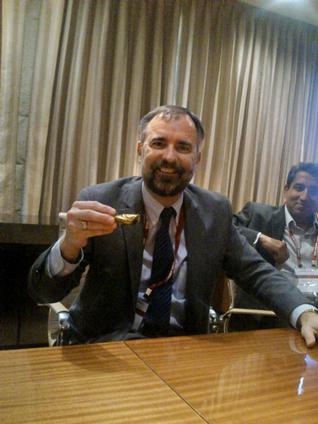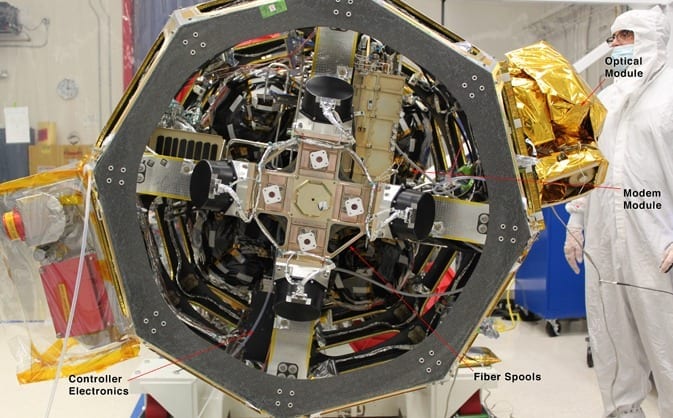
When Gary Patton pulls a thin, round wafer-like sheet from his coat pocket, he makes no attempts to conceal his excitement.
“It’s cutting-edge innovation!” says the man who heads IBM’s research and development operations worldwide, as he holds out what seems like a thin, metallic sheet. Then, with childlike excitement, he folds the circular sheet into a neat triangle, then unfolds it and rolls it into a thin cigarette.
The metallic sheet that Dr. Patton is gung-ho about represents a major breakthrough in material sciences, one that will drive high-performance computing to a new level, ushering in a new paradigm in silicon and electronic circuits. A closer look at the round patch reveals that beneath the shiny surface is an intricate network of circuits that looks much like your regular printed circuit board.
FLEXIBLE CIRCUITS
Made of silicon, this wafer, he says, holds the future. Also called flexible circuits, these, for now, are a huge step for portable computing, but the possibilities are endless.
They can power your mobile devices, you can have embedded electronics in your body, say to monitor health parameters, or even actively make biomedical interventions, Dr. Patton told The Hindu on the sidelines of the Indian Electronics and Semiconductor Associations (IESA) summit here last month. This, he says, will allow for products that will usher in the era of ‘anywhere computing’, the stuff that we’ve only read abut in futuristic literature or sci-fi.
WHAT’S IT ALL ABOUT?
So what’s this flexible wafer all about? Silicon wafers are typically hard and thick structures, processed in large fabs to make integrated circuits and other micro-devices. In IBM’s research centre, Dr. Patton explains, scientists have selectively cleaved the silicon substrate into a “very, very thin layer, thinner than paper”. “When we did this, we found that the characteristics of the material did not change significantly. It’s really a major breakthrough; it’s the stuff of sci-fi,” he gushes. The research, he said, suggests that such wafers can be made with conventional processes at room temperature, and the process is entirely scalable. But how long will it be before something like this takes the form of a product? “Not too long.”
This was among the key recent breakthroughs demonstrated by IBM at the Common Platform Technology Forum earlier this year. Other exciting systems on insulator (SOI) research showcased included breakthroughs in the field of carbon nanotubes and silicon nanophotonics.
‘TRANSITION POINT’
Dr. Patton said that the semiconductor industry is at “a significant transition point”, where process engineering has reached the limit of being able to engineer material by changing fundamental properties of silicon by introducing strain or using High K metal gates to change the properties of gate oxides; all technical processes that were used up until now to fuel growth in computing power. Currently, Dr. Patton said, the semiconductor industry is in what he calls the 3D era, where devices known as Fin-Fets are being integrated in 3D.
“This is going to result in a real explosion in the next decade in the mobile interconnect of devices. That will take us into 2020, but at some point 3D will run its course and we’ll hit the atomic dimension limit. By then, we’ll be going to new types of materials, and this is where we’ll come into the nanotechnology era… things like carbon nanotubes, silicon nanowires or even the use of photonics where light will replace conventional electrical signals. These will have tremendous benefits in improving the speed of the circuit.”
But what was driving this explosion in demand for computing power, asked Dr. Patton, speaking at the IESA summit. He said it was “about simple economics, at the end of the day.” He explained: “You can make smaller features, you get better performance, you get better cost per function and you can do more applications. What you can do on the phone has grown dramatically over the last few years and, guess what, we have an explosion in the market.
“Consider the difference in transistor price. The relative price of a transistor has gone down by five orders of magnitude over the last 30 years, while the number of transistors consumed per year has gone up by six orders of magnitude over the same period. At the end of the day, it’s all about economics.”
The Latest Bing News on:
Anywhere computing
- Comeback Town: Birmingham’s surprising opportunityon April 28, 2024 at 8:17 am
The Birmingham Lede states that Jefferson County’s population declined almost 2% since 2020 with 3,417 people moving away. However, 818 people made an international move to the Birmingham area making ...
- This mini PC, and I do mean mini, has a Ryzen 7000 tucked inside for $200 offon April 26, 2024 at 8:00 am
The Geekom A7 Mini PC has a powerful Ryzen 7 tucked inside, with 64GB of DDR5 RAM, all in a case about the size of a book.
- The Inflation ‘Wedge’ Is Sticking Around. Here’s Why.on April 26, 2024 at 8:00 am
The so-called "inflation wedge" isn't going anywhere, March data show. With the release of the Federal Reserve's [preferred inflation gauge]( ...
- Nvidia’s Acquisition Of Run:ai Emphasizes The Importance Of Kubernetes For Generative AIon April 25, 2024 at 10:41 pm
NVIDIA's move to acquire Run:ai not only strengthens its position in the AI and cloud computing markets but also enhances the Kubernetes ecosystem's capacity to support the next generation of AI ...
- March PCE: Inflation Ticks Upon April 25, 2024 at 3:28 pm
The personal-consumption expenditures, or PCE, price index for March will be published at 8:30 a.m. ET on Friday as part of the Bureau of Economic Analysis’ personal income and outlays report.
- NVIDIA to Acquire GPU Orchestration Software Provider Run:aion April 25, 2024 at 5:27 am
To help customers make more efficient use of their AI computing resources, NVIDIA today announced it has entered into a definitive ...
- Scale Computing Revolutionizes IT Efficiency With Virtual Desktop Infrastructure (VDI)on April 24, 2024 at 5:00 am
Scale Computing, a market leader in edge computing, virtualization, and hyperconverged solutions, today announced a campaign to promote its virtual desktop infrastructure (VDI) technology. For a ...
- Exclusive: Brev.dev joins forces with Akash Network to offer on-demand GPUs for AI developerson April 23, 2024 at 3:00 pm
Brev.dev partners with Akash Network to provide AI developers with on-demand access to decentralized GPU resources, revolutionizing AI development and democratizing access to high-performance ...
- Mark Zuckerberg Just Made It Official: Meta Is Going Open-Model With Horizon OSon April 23, 2024 at 1:17 pm
Zuckerberg announced that Meta will open up Meta Horizon OS, the operating system that powers the company's line of virtual reality and mixed-reality headsets, to companies like Lenovo, ASUS, and ...
- The 7 Major Benefits of Cloud Computing for Small Businesseson April 22, 2024 at 10:42 am
Your guide to the best in personal financial products such as credit cards, mortgages, bank accounts, and brokerages.
The Latest Google Headlines on:
Anywhere computing
[google_news title=”” keyword=”anywhere computing” num_posts=”10″ blurb_length=”0″ show_thumb=”left”] [/vc_column_text]The Latest Bing News on:
High-performance computing
- Arm integrates AI capabilities into IoT chips designed for edge computing applications.on April 27, 2024 at 3:00 am
In an ambitious move to redefine the landscape of edge computing, Arm, the semiconductor architecture titan headquartered in Cambridge, England, has announced the launch of groundbreaking edge AI ...
- Rigetti Computing Launches the Novera™ QPU Partner Programon April 26, 2024 at 7:30 am
The Novera QPU Partner Program aims to enable high-performing, on-premises quantum computing by creating an ecosystem of quantum computing ...
- Quantum Computing Meets Genomics: The Dawn of Hyper-Fast DNA Analysison April 26, 2024 at 2:13 am
A new project unites world-leading experts in quantum computing and genomics to develop new methods and algorithms to process biological data. Researchers aim to harness quantum computing to speed up ...
- Duke Researcher Dr. Amanda Randles Wins ACM Prize in Computing for Medical Diagnosticson April 25, 2024 at 11:31 am
The Association for Computing Machinery, named Amanda Randles of Duke University the recipient of the ACM Prize in Computing for groundbreaking contributions to computational health through innovative ...
- Innovative solutions for sustainable high-performance computingon April 24, 2024 at 5:00 pm
High performance computing (HPC) is revolutionising the problem-solving capabilities of engineers, data scientists and other IT specialists across a range of industries, worldwide. By Tony Bartlett, ...
- high performance computingon April 21, 2024 at 5:00 pm
It was designed to put high performance computing in a small and energy efficient enough package that it could be integrated directly into products, rather than connecting to a data center half ...
- High Performance Computing (HPC) Chipset Market CAGR of 19.1%, Size Explorer’s Handbook to Unveiling Growthon April 21, 2024 at 2:48 pm
Report Ocean recently added a research report on “High Performance Computing (HPC) Chipset Market”. The report includes an extensive analysis of the market’s characteristics, COVID-19 impact, size and ...
- Researchers Blazing New Trails with Superchip Named After Computing Pioneeron April 19, 2024 at 5:00 am
Computing research at Georgia Tech is getting faster thanks to a new state-of-the-art processing chip named after a female computer programming pioneer. Tech is one of the first research universities ...
- ceτi AI Acquires Big Energy Investments Inc. to Boost Its High-Performance Computing Capabilities in North Americaon April 18, 2024 at 7:08 am
ceτi AI, a leader in decentralized artificial intelligence infrastructure, is pleased to announce its acquisition of Canadian company Big Energy Investments Inc., a firm specializing in strategic ...
- AMD Reveals Ryzen Pro 8000 Series for High-Performance Computing Needs, Including AIon April 16, 2024 at 1:42 pm
AMD said its Ryzen AI chip with the Ryzen Pro 8000 series can perform at 16 mobile dedicated NPU TOPS (i.e., TOPS is a measurement of how many mathematical operations a chip can perform in a second, ...
The Latest Google Headlines on:
High-performance computing
[google_news title=”” keyword=”high-performance computing” num_posts=”10″ blurb_length=”0″ show_thumb=”left”]









